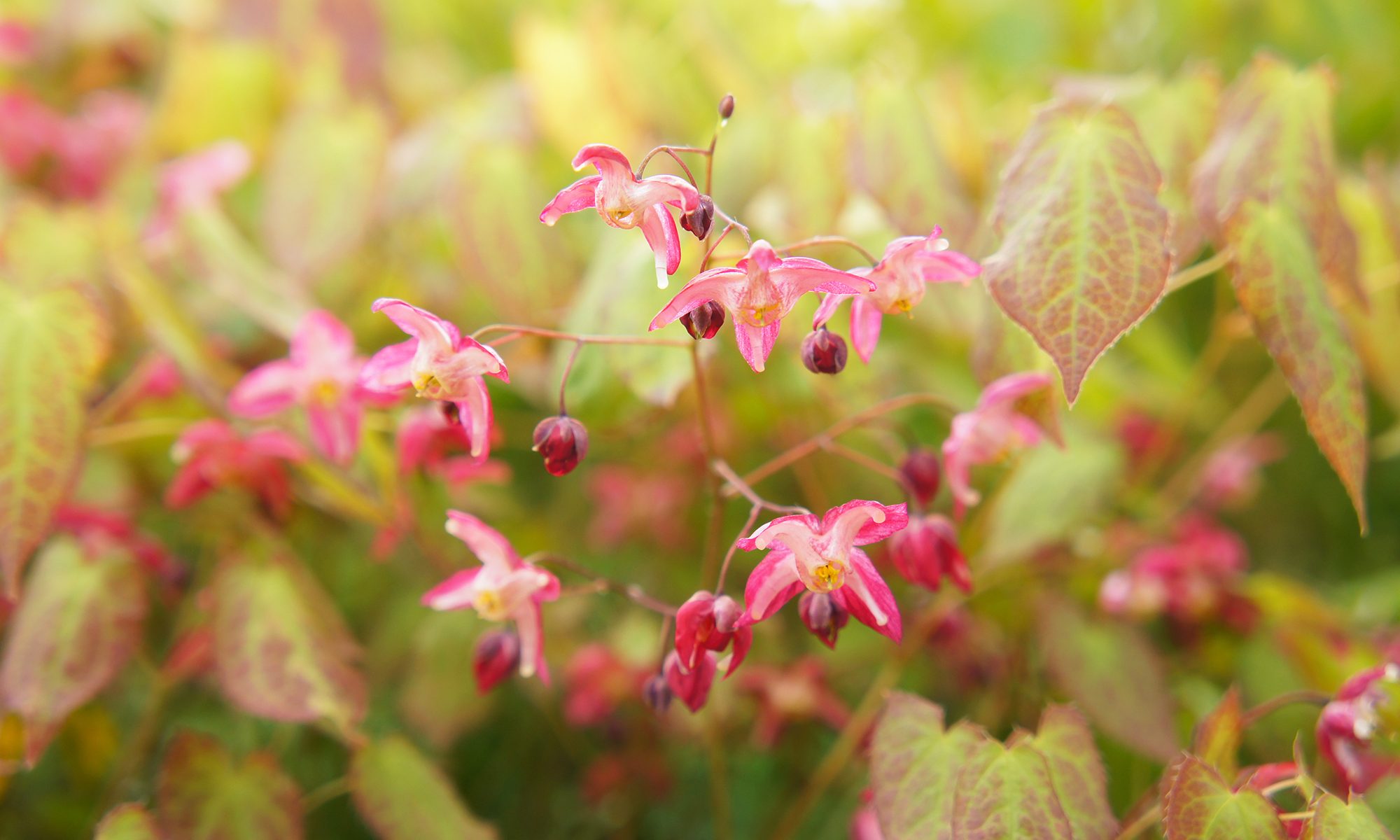Sue Whigham explores the oh-so delicate world of epimediums –
personal favourites that are a little harder to track down
I’m happy that other names for epimediums include barrenwort, ‘Bishop’s hat’ and ‘fairy wings’ – but ‘horny goat weed’ is going too far for a genus of flowering plants which are not only beautiful but so delicate and so desirable.
There are more than fifty confirmed species of epimedium but no doubt others will be added to the list with the development of more hybrids and more species being discovered in China. Epimediums in the wild grow in woodland, in mountainous regions and on river banks in China and other parts of Asia, as well as in Mediterranean regions. They are in the Berberidaceae family and vary enormously in both leaf shape and colour, as well as flower shape and colour. The flowers can come in shades of yellow through to orange and many shades of pink, red through to mauves and purples. Flower shapes include small hanging cup shapes or bells to pendulous stars resembling dangling spiders where the flower is ‘predominantly long spurred petals’.
I think that as more hybrids are produced with more easily remembered names, like the lovely E. ‘Pink Champagne’, there will be more epimediums sold in garden centres. Specialist nurseries are more used to fairly unpronounceable Latin names but not so the garden centres. Imagine trying to ask for E. lishihchenii or E. membranaceum unless you are feeling fairly confident. Shame really as both plants are lovely. E. membranaceum has a long flowering season from late April through until August – as well as a long name. It’s a recent introduction from China and has luminous yellow flowers and elongated serrated leaves.
Some are ideal for dry conditions, under trees and shrubs, as long as there is some light. In other words, dappled shade rather than dark conditions. They are perfect as ground cover plants, some spreading over the ground wonderfully fast. One such plant is the hybrid (and the fastest growing) E x versicolor ‘Sulphureum’. Cut down last year’s shabby foliage to the ground early in the year so that the flowers on their wiry red stems can be seen and enjoyed before the mottled heart-shaped leaves appear. You can see drifts of it at RHS Wisley (if you can face the road works) and the RHS are now adding newer varieties in the woodland garden and in the shadier parts of the rock garden. They are ideal companions for spring plants such as hellebores, primroses and spring bulbs.
What do epimediums need?
They require some shade and will do their best if you prepare the site first, adding some organic matter before you plant. There are some varieties that can take sun, so it’s worth doing your homework before you buy. Once your plants are in, keep them watered in their first year, especially if we have a dry spell. Epimediums are hardy despite looking so delicate and can cope with cold, wintry conditions.
My first epimedium was E. ‘Amber Queen’, AGM. This one has a long flowering season and has serrated leaves topped with orangey-yellow flowers above dark wiry stems and seems to be as tough as old boots. I’m not sure about the colour now but as the plant is rhizomatus it has made a good sized clump over the past five years so and earned its place in a rather overcrowded shady border. I think that some of the newer hybrids are very tempting. Who could resist E. ‘Fire Dragon’ with its description of amber and silver foliage topped with pink and yellow flowers. And the vigorous E. grandifolium ‘Lilac Seedling’ with arrow shaped bronze-green leaves and lilac flowers appearing in April. This particular wish list is growing.
Where to see them
There is a National Collection of Epimediums set up by Roger and Linda Hammond in 2013 (themagnolias.co.uk).
They are based in Brentwood, Essex. Roger’s interest in epimediums began when he was at horticultural college and saw epimediums displayed on a Blackthorn’s stand at a RHS Show. They have a good, comprehensive website and open their garden and collection in April. He recommends Sally Gregson’s book, The Plant Lover’s Guide to Epimediums. Many of the illustrations in the book come from the National Collection. Sally’s nursery, Mill Cottage Plants in Wookey, Somerset, has epimediums growing under her other love: hydrangeas. It was interesting to see that she was inspired by Elizabeth Strangman’s nursery in Hawkhurst, Kent, which unfortunately closed in 1999.
Where to buy them
There are now many nurseries supplying epimediums which include Edrom Nurseries edrom-nurseries.co.uk,
Burncoose Nurseries burncoose.co.uk,
Hardy’s Cottage Garden plants hardysplants.co.uk,
Beth Chatto bethchatto.co.uk
Dorset Perennials dorsetperennials.co.uk.
Sue Whigham can be contacted on 07810 457948 for gardening advice and help in the sourcing and supply of interesting garden plants.
You may also like
In the Night Garden
Jo Arnell explains how to make the most of your outdoor space once darkness falls Some enchanted evening you may see me outside – mainly searching for slugs in the garden, because the cool hours of night are when they...
Contain your excitement
Jen Stuart-Smith discusses how to get creative with your pots and planters My love affair with plants started with houseplants when I was a child. As my bedroom windowsill overflowed – resulting, occasionally, in waking up with compost under my...
More than just a pretty face
Jen Stuart-Smith explores the multiple uses of some easy-to-grow garden favourites When you grow flowers for their beauty, shape and colour it can be easy to forget all the other qualities they have to offer. Some are edible, others provide...










